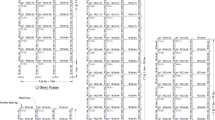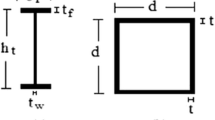Abstract
In this paper, a simpler and more effective procedure, called the single-run multi-mode pushover (SMP) analysis, is proposed to account for the effect of higher modes in estimating the seismic demands of tall buildings. The main simplification of this procedure is that the effect of higher modes is concentrated into a single invariant lateral force distribution computed by algebraically adding the modal story forces whereby a single-run multi-mode pushover analysis is implemented. An important advantage of the proposed procedure is that the spectral pseudo-acceleration of ground motions (or design spectrum) as a weighting parameter as well as the effective modal mass ratio is incorporated into the modal story forces. Then, the effect of the frequency content of ground motions is considered in the modal lateral forces. Another advantage of the SMP procedure is that the reversal of sign in the story forces of higher modes is taken into account. In this procedure, the seismic demands are finally obtained by enveloping the results of single-run conventional and single-run multi-mode pushover analyses. To assess the accuracy of the proposed procedure, three special steel moment-resisting frames are considered. The seismic demands resulting from the SMP procedure are compared to those from the nonlinear response history analysis as a benchmark solution, as well as to those predicted from the modal pushover analysis and the consecutive modal pushover procedures. The results demonstrate that the SMP procedure can accurately estimate the seismic demands of tall buildings.








Similar content being viewed by others
References
Abbasnia R, Tajik Davoudi A (2013) An adaptive pushover procedure based on effective modal mass combination rule. Eng Struct 52:654–666
American Society of Civil Engineers (ASCE) (2007) Seismic rehabilitation of existing buildings. ASCE Standard No. ASCE/SEI 41–06
Antoniou S, Pinho R (2004a) Advantages and limitations of adaptive and non-adaptive force-based pushover procedures. J Earthq Eng 8(4):497–522
Antoniou S, Pinho R (2004b) Development and verification of a displacement-based adaptive pushover procedure. J Earthq Eng 8(5):643–661
ATC (1996) Seismic evaluation and retrofit of concrete buildings. Report ATC-40. Redwood City (CA): Applied Technology Council
CEN. Pr-EN 1998–1 (2003) Eurocode 8: design of structures for earthquake resistance, part 1: final draft. European Committee for Standardization, Brussels (BEL)
Chopra AK (2001) Dynamics of structures. Theory and applications to earthquake engineering, 2nd edn. Prentice Hall, Englewood Cliffs, NJ
Chopra AK, Goel RK (2002) A modal pushover analysis procedure for estimating seismic demands for buildings. Earthq Eng Struct Dyn 31:561–582
Chopra AK, Goel RK (2004) A modal pushover analysis procedure to estimate seismic demands for unsymmetrical-plan buildings. Earthq Eng Struct Dyn 33(8):903–927
Chopra AK, Goel RK (2005) Role of higher-mode pushover analyses in seismic analysis of buildings. Earthq Spectra 21(4):1027–1041
Chopra AK, Goel RK, Chintanapakdee C (2004) Evaluation of a modified MPA procedure assuming higher modes as elastic to estimate seismic demands. Earthq Spectra 20(3):757–778
Fajfar P (2000) A nonlinear analysis method for performance based seismic design. Earthq Spectra 16(3):573–592
FEMA (2000) Prestandard and commentary for the seismic rehabilitation of buildings. FEMA 356Federal Emergency Management Agency, Washington (DC)
Gupta B, Kunnath SK (2000) Adaptive spectra-based pushover procedure for seismic evaluation of structures. Earthq Spectra 16(2):367–391
Jan TS, Liu MW, Kao YC (2004) An upper-bound pushover analysis procedure for estimating the seismic demands of high-rise buildings. Eng Struct 26:117–128
Kalkan E, Kunnath SK (2006) Adaptive modal combination procedure for nonlinear static analysis of building structures. J Struct Eng ASCE 132(11):1721–1731
Kim S-P, Kurama YC (2008) An alternative pushover analysis procedure to estimate seismic displacement demands. Eng Struct 30:3793–3807
Krawinkler H, Seneviratna GDPK (1998) Pros and cons of a pushover analysis of seismic performance evaluation. Eng Struct 20(4–6):452–462
Kreslin M, Fajfar P (2011) The extended N2 method taking into account higher mode effects in elevation. Earthq Eng Struct Dyn. doi:10.1002/eqe.1104
Kunnath SK (2004) Identification of modal combination for nonlinear static analysis of building structures. Comput-Aided Civ Eng 19:246–259
Matsumori T, Otani S, Shiohara H, Kabeyasawa T (1999) Earthquake member deformation demands in reinforced concrete frame structures. In: Proceeding of the US-Japan workshop on performance-based earthquake engineering methodology for RC building structure
Mwafy AM, Elnashai AS (2001) Static pushover versus dynamic analysis of R/C buildings. Eng Struct 23:407–424
OpenSees (2013) Open system for earthquake engineering simulation. Pacific Earthquake Engineering Research Center, University of California, Berkeley CA. http://opensees.berkeley.edu/
Panyakapo P (2014) Cyclic pushover analysis procedure to estimate seismic demands for buildings. Eng Struct 66:10–23
Papanikolaou VK, Elnashai AS, Pareja JF (2006) Evaluation of conventional and adaptive pushover analysis II: comparative results. J Earthq Eng 10(1):127–151
Poursha M, Khoshnoudian F, Moghadam AS (2009) A consecutive modal pushover procedure for estimating the seismic demands of tall buildings. Eng Struct 31:591–599
Poursha M, Khoshnoudian F, Moghadam AS (2010) Assessment of modal pushover analysis and conventional nonlinear static procedure with load distributions of Federal Emergency Management Agency for high-rise buildings. J Struct Des Tall Spec Build 19(3):291–308
Poursha M, Khoshnoudian F, Moghadam AS (2011) A consecutive modal pushover procedure for nonlinear static analysis of one-way unsymmetric-plan tall building structures. Eng Struct 33:2417–2434
Poursha M, Khoshnoudian F, Moghadam AS (2014) The extended consecutive modal pushover procedure for estimating the seismic demands of two-way unsymmetric-plan tall building structures under influence of two horizontal components of ground motions. J Soil Dyn Earthq Eng 63:162–173
Reyes JC, Chopra AK (2011) Three-dimensional modal pushover analysis of buildings subjected to two components of ground motion, including its evaluation for tall buildings. Earthq Eng Struct Dyn 40:789–806
Shakeri K, Shayanfar MA, Kabeyasawa T (2010) A story shear-based adaptive pushover procedure for estimating seismic demands of buildings. Eng Struct 32:174–183
Standard No. 2800–05 (2005) Iranian code of practice for seismic resistant design of buildings, 3rd edn. Building and Housing Research Centre, Iran
Sucuoglu H, Selim Gunay M (2011) Genralized force vectors for multi-mode pushover analysis. Earthq Eng Struct Dyn 40:55–74
Tso WK, Moghadam AS (1998) Pushover procedure for seismic analysis of buildings. Prog Struct Eng Mater 1(3):337–344
Acknowledgments
This research investigation was carried out in the continuation of a preliminary study done by the first author and Hiva Pirsaheb, an MSc student in Sahand University of Technology, on reinforced concrete (RC) moment resistant building frames.
Author information
Authors and Affiliations
Corresponding author
Rights and permissions
About this article
Cite this article
Poursha, M., Amini, M.A. A single-run multi-mode pushover analysis to account for the effect of higher modes in estimating the seismic demands of tall buildings. Bull Earthquake Eng 13, 2347–2365 (2015). https://doi.org/10.1007/s10518-014-9721-y
Received:
Accepted:
Published:
Issue Date:
DOI: https://doi.org/10.1007/s10518-014-9721-y




